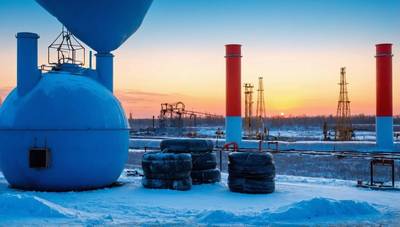How can the EU ban Russian Gas?
Next month, the European Commission will propose legal measures that will phase out EU gas imports from Russia by 2027 and prohibit spot contracts with Russia before the end this year.
This is how it could work.
How will the EU ban Russian gas?
Legally, sanctions are the easiest way for the EU's to prohibit Russian gas and liquefied imports. They require the unanimous approval of all 27 EU member states.
Hungary and Slovakia have pledged to block any gas sanctions, as they want to keep close political ties to Russia. Both countries import gas via the Turkstream pipe and claim that switching to alternative sources would raise energy prices.
In June, the European Commission proposes alternative measures which will only need to be approved by four countries.
EU diplomats reported that in a meeting held behind closed doors last week with ambassadors from EU member states, all but Hungary and Slovakia welcomed a plan to ban Russian Gas. Some raised concerns over the legal certainty and impact of the EU plan on energy prices.
If not SANCTIONS then HOW?
The Commission declined to reveal the specific legal instruments on which it is working. EU diplomats suggest a few possible options.
Tariffs could be imposed on Russian LNG and gas imports. Tariffs, while not a ban in the strictest sense, would be aimed at making new Russian gas agreements economically unfeasible.
The EU tariffs on Russian fertilizers are a good example of what could happen. The EU is planning to increase the tariff on Russian fertilisers from 430 euros to 481.21 dollars per ton in three years. This "prohibitive level" will effectively stop imports.
These tariffs may also allow European companies that have long-term Russian Gas contracts to claim that EU regulations have changed so much that their contracts no longer meet the requirements and to invoke "force majeure".
However, lawyers have warned that this could result in financial penalties.
How can a ban be enforced?
The governments say that more transparency in the Russian gas market will be critical. The EU could achieve this by using the "Union Database", an EU platform that tracks EU imports for biofuels.
This tool could be used to track Russian gas, and to reveal which companies trade it. It would allow officials to target traders or suppliers who violate the ban.
In the Commission's proposals for June, companies will be required to provide information about their Russian gas contracts.
Who will be most affected?
The EU intends to end long-term contracts for gas imports from Russia by the end of 2027. Rest is spot trading.
Last year, Russia provided 19% of EU imports through LNG and the TurkStream pipeline that supplied Hungary and Slovakia.
This is a far cry from the 45% that Russia provided to Europe before it invaded Ukraine on a full scale in 2022. After the Ukrainian pipelines stop delivering gas to Europe at the end 2024, Russia's share of Europe's gas is expected to drop to 13% in this year.
The majority of EU countries who previously relied on Russian pipelines have now switched to alternative sources. Austria, which imported Russian gas through Ukraine until the end of 2024, imports it now via Germany and Italy.
Moving to alternative energy sources will be expensive for Hungary and Slovakia. According to an analysis by the Center for the Study of Democracy, Russian pipeline gas was offered at a discount of 13-15% compared to other options.
LNG is a different story. Belgium, France, and Spain import the majority of Russian LNG into Europe and can easily replace it with supplies from other countries, like the U.S.
Some Russian LNG contracts, however, are long-term and, if not interrupted, could last until 2041. These contracts are held by TotalEnergies SEFE, and Naturgy.
(source: Reuters)





